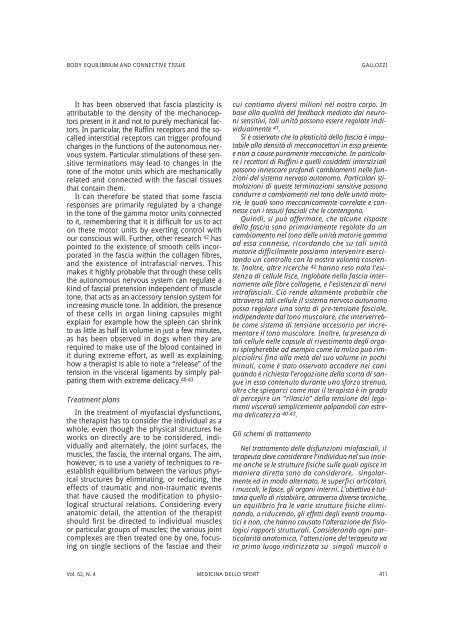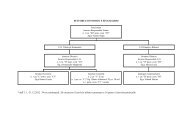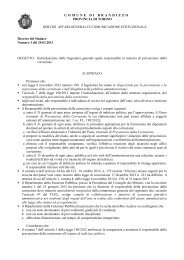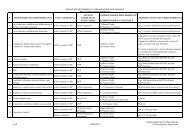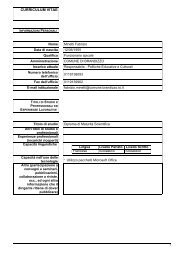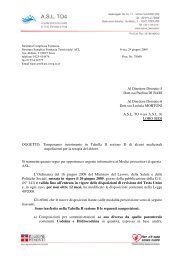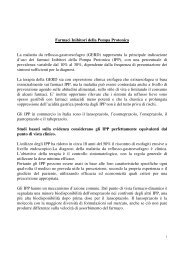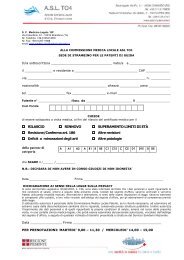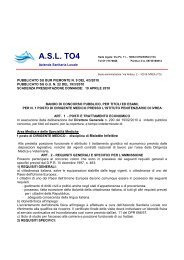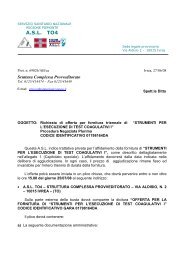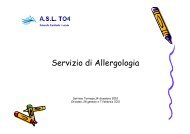Articolo sulla casistica delle non idoneità allo sport agonistico in ...
Articolo sulla casistica delle non idoneità allo sport agonistico in ...
Articolo sulla casistica delle non idoneità allo sport agonistico in ...
You also want an ePaper? Increase the reach of your titles
YUMPU automatically turns print PDFs into web optimized ePapers that Google loves.
BODY EQUILIBRIUM AND CONNECTIVE TISSUE GALLOZZI<br />
It has been observed that fascia plasticity is<br />
attributable to the density of the mechanoceptors<br />
present <strong>in</strong> it and not to purely mechanical factors.<br />
In particular, the Ruff<strong>in</strong>i receptors and the socalled<br />
<strong>in</strong>terstitial receptors can trigger profound<br />
changes <strong>in</strong> the functions of the autonomous nervous<br />
system. Particular stimulations of these sensitive<br />
term<strong>in</strong>ations may lead to changes <strong>in</strong> the<br />
tone of the motor units which are mechanically<br />
related and connected with the fascial tissues<br />
that conta<strong>in</strong> them.<br />
It can therefore be stated that some fascia<br />
responses are primarily regulated by a change<br />
<strong>in</strong> the tone of the gamma motor units connected<br />
to it, remember<strong>in</strong>g that it is difficult for us to act<br />
on these motor units by exert<strong>in</strong>g control with<br />
our conscious will. Further, other research 42 has<br />
po<strong>in</strong>ted to the existence of smooth cells <strong>in</strong>corporated<br />
<strong>in</strong> the fascia with<strong>in</strong> the collagen fibres,<br />
and the existence of <strong>in</strong>trafascial nerves. This<br />
makes it highly probable that through these cells<br />
the autonomous nervous system can regulate a<br />
k<strong>in</strong>d of fascial pretension <strong>in</strong>dependent of muscle<br />
tone, that acts as an accessory tension system for<br />
<strong>in</strong>creas<strong>in</strong>g muscle tone. In addition, the presence<br />
of these cells <strong>in</strong> organ l<strong>in</strong><strong>in</strong>g capsules might<br />
expla<strong>in</strong> for example how the spleen can shr<strong>in</strong>k<br />
to as little as half its volume <strong>in</strong> just a few m<strong>in</strong>utes,<br />
as has been observed <strong>in</strong> dogs when they are<br />
required to make use of the blood conta<strong>in</strong>ed <strong>in</strong><br />
it dur<strong>in</strong>g extreme effort, as well as expla<strong>in</strong><strong>in</strong>g<br />
how a therapist is able to note a “release” of the<br />
tension <strong>in</strong> the visceral ligaments by simply palpat<strong>in</strong>g<br />
them with extreme delicacy. 40-43<br />
Treatment plans<br />
In the treatment of myofascial dysfunctions,<br />
the therapist has to consider the <strong>in</strong>dividual as a<br />
whole, even though the physical structures he<br />
works on directly are to be considered, <strong>in</strong>dividually<br />
and alternately, the jo<strong>in</strong>t surfaces, the<br />
muscles, the fascia, the <strong>in</strong>ternal organs. The aim,<br />
however, is to use a variety of techniques to reestablish<br />
equilibrium between the various physical<br />
structures by elim<strong>in</strong>at<strong>in</strong>g, or reduc<strong>in</strong>g, the<br />
effects of traumatic and <strong>non</strong>-traumatic events<br />
that have caused the modification to physiological<br />
structural relations. Consider<strong>in</strong>g every<br />
anatomic detail, the attention of the therapist<br />
should first be directed to <strong>in</strong>dividual muscles<br />
or particular groups of muscles; the various jo<strong>in</strong>t<br />
complexes are then treated one by one, focus<strong>in</strong>g<br />
on s<strong>in</strong>gle sections of the fasciae and their<br />
cui contiamo diversi milioni nel nostro corpo. In<br />
base alla qualità del feedback mediato dai neuroni<br />
sensitivi, tali unità possono essere regolate <strong>in</strong>dividualmente<br />
41.<br />
Si è osservato che la plasticità della fascia è imputabile<br />
alla densità di meccanocettori <strong>in</strong> essa presente<br />
e <strong>non</strong> a cause puramente meccaniche. In particolare<br />
i recettori di Ruff<strong>in</strong>i e quelli cosiddetti <strong>in</strong>terstiziali<br />
possono <strong>in</strong>nescare profondi cambiamenti nelle funzioni<br />
del sistema nervoso autonomo. Particolari stimolazioni<br />
di queste term<strong>in</strong>azioni sensitive possono<br />
condurre a cambiamenti nel tono <strong>delle</strong> unità motorie,<br />
le quali sono meccanicamente correlate e connesse<br />
con i tessuti fasciali che le contengono.<br />
Qu<strong>in</strong>di, si può affermare, che alcune risposte<br />
della fascia sono primariamente regolate da un<br />
cambiamento nel tono <strong>delle</strong> unità motorie gamma<br />
ad essa connesse, ricordando che su tali unità<br />
motorie difficilmente possiamo <strong>in</strong>tervenire esercitando<br />
un controllo con la nostra volontà cosciente.<br />
Inoltre, altre ricerche 42 hanno reso nota l’esistenza<br />
di cellule lisce, <strong>in</strong>globate nella fascia <strong>in</strong>ternamente<br />
alle fibre collagene, e l’esistenza di nervi<br />
<strong>in</strong>trafasciali. Ciò rende altamente probabile che<br />
attraverso tali cellule il sistema nervoso autonomo<br />
possa regolare una sorta di pre-tensione fasciale,<br />
<strong>in</strong>dipendente dal tono muscolare, che <strong>in</strong>terverrebbe<br />
come sistema di tensione accessorio per <strong>in</strong>crementare<br />
il tono muscolare. Inoltre, la presenza di<br />
tali cellule nelle capsule di rivestimento degli organi<br />
spiegherebbe ad esempio come la milza può rimpicciolirsi<br />
f<strong>in</strong>o alla metà del suo volume <strong>in</strong> pochi<br />
m<strong>in</strong>uti, come è stato osservato accadere nei cani<br />
quando è richiesta l’erogazione della scorta di sangue<br />
<strong>in</strong> essa contenuto durante uno sforzo strenuo,<br />
oltre che spiegarci come mai il terapista è <strong>in</strong> grado<br />
di percepire un “rilascio” della tensione dei legamenti<br />
viscerali semplicemente palpandoli con estrema<br />
delicatezza 40-43.<br />
Gli schemi di trattamento<br />
Nel trattamento <strong>delle</strong> disfunzioni miofasciali, il<br />
terapeuta deve considerare l’<strong>in</strong>dividuo nel suo <strong>in</strong>sieme<br />
anche se le strutture fisiche sulle quali agisce <strong>in</strong><br />
maniera diretta sono da considerare, s<strong>in</strong>golarmente<br />
ed <strong>in</strong> modo alternato, le superfici articolari,<br />
i muscoli, le fasce, gli organi <strong>in</strong>terni. L’obiettivo è tuttavia<br />
quello di ristabilire, attraverso diverse tecniche,<br />
un equilibrio fra le varie strutture fisiche elim<strong>in</strong>ando,<br />
o riducendo, gli effetti degli eventi traumatici<br />
e <strong>non</strong>, che hanno causato l’alterazione dei fisiologici<br />
rapporti strutturali. Considerando ogni particolarità<br />
anatomica, l’attenzione del terapeuta va<br />
<strong>in</strong> primo luogo <strong>in</strong>dirizzata su s<strong>in</strong>goli muscoli o<br />
Vol. 62, N. 4 MEDICINA DELLO SPORT 411


